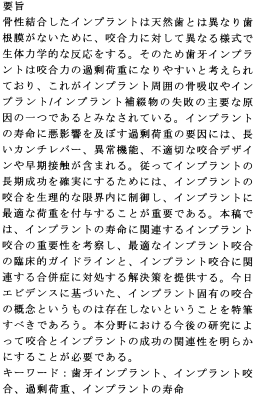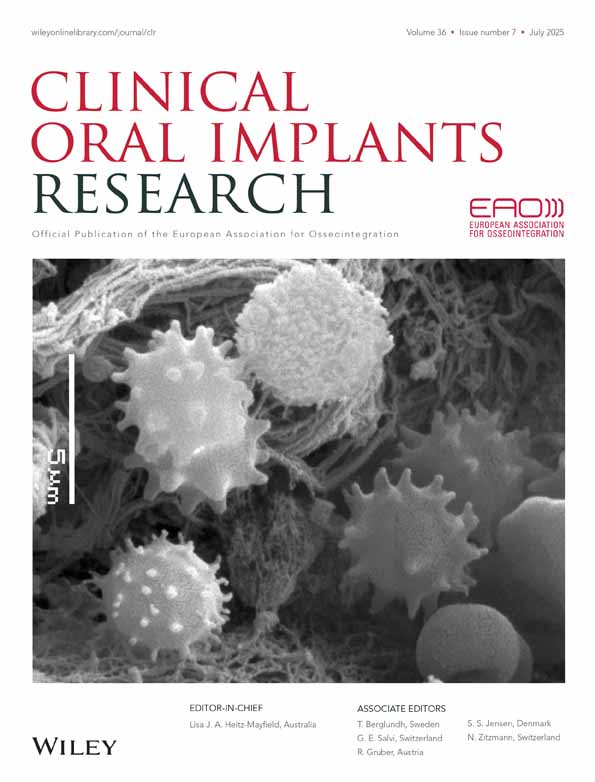Occlusal considerations in implant therapy: clinical guidelines with biomechanical rationale
Abstract
enAbstract: Due to lack of the periodontal ligament, osseointegrated implants, unlike natural teeth, react biomechanically in a different fashion to occlusal force. It is therefore believed that dental implants may be more prone to occlusal overloading, which is often regarded as one of the potential causes for peri-implant bone loss and failure of the implant/implant prosthesis. Overloading factors that may negatively influence on implant longevity include large cantilevers, parafunctions, improper occlusal designs, and premature contacts. Hence, it is important to control implant occlusion within physiologic limit and thus provide optimal implant load to ensure a long-term implant success. The purposes of this paper are to discuss the importance of implant occlusion for implant longevity and to provide clinical guidelines of optimal implant occlusion and possible solutions managing complications related to implant occlusion. It must be emphasized that currently there is no evidence-based, implant-specific concept of occlusion. Future studies in this area are needed to clarify the relationship between occlusion and implant success.
Résumé
frVu l'absence de ligament parodontal, les implants ostéoïntégrés, contrairement aux dents naturelles, réagissent biomécaniquement d'une manière différente aux forces occlusales. Les implants dentaires seraient alors plus aptes à supporter la surcharge occlusale qui est souvent considérée comme une des causes potentielles de la perte osseuse paroïmplantaire et de l'échec des prothèses sur implants. Les facteurs de surcharge qui pourraient influencer négativement la longévité implantaire comprennent des porte-à-faux étendus, des parafonctions, des dessins occlusaux impropres et des contacts prématurés. Il est donc important au niveau des implants de contrôler l'occlusion dans une limite physiologique et donc d'apporter une charge implantaire optimale qui permette un succès implantaire à long terme. Les buts de ce manuscript ont été de discuter l'importance de l'occlusion implantaire dans la longévité implantaire et d'apporter des guides cliniques de l'occlusion implantaire optimale et des solutions possibles pour arranger les complications en relation avec l'occlusion implantaire. Aucune étude basée sur l'évidence ayant un concept spécifique de l'occlusion au niveau des implants n'existe actuellement. Davantage d'études dans ce domaine sont nécessaires afin de clarifier la relation entre occlusion et succès en implantologie.
Zusammenfassung
deWeil ihnen das parodontale Ligament fehlt reagieren osseointegrierte Implantate biomechanisch auf okklusale Kräfte anders als natürliche Zähne. Man glaubte daher, dass Zahnimplantate anfälliger auf okklusale Überlastungen sind. Sie wurde somit auch als eine der Hauptursachen für den periimplantären Knochenverlust und den Misserfolg von Implantaten und implantatgetragenen Rekonstruktionen genannt. Faktoren, die zu einer Überlastung führen können und die sich negativ auf die Langzeitprognose von Implantaten auswirken können sind grosse Extensionsglieder, Parafunktionen, unsaubere Okklusionsgestaltung und Vorkontakte. Daher ist es wichtig, dass kontrolliert wird, ob die Okklusion der Implantate innerhalb der physiologischen Grenzen liegt, um so eine optimale Implantatbelastung und einen Langzeiterfolg für die Implantate zu garantieren. Die Ziele dieser Arbeit sind, die Wichtigkeit der Implantatokklusion für den Langzeiterfolg eines Implantates zu besprechen, klinische Richtlinien für eine optimale Implantatokklusion herauszuarbeiten und mögliche Lösungen zur Beherrschung von okklusionsbedingten Problemen bei Implantaten zu entwickeln. Es muss mit Nachdruck betont werden, dass es im Moment kein klinisch bewiesenes Okklusionskonzept spezifisch für Implantate gibt. Zukünftige Studien auf diesem Gebiet sollten in diese Richtung gehen und die Beziehung zwischen der Okklusion und dem Implantaterfolg klären.
Resumen
esDebido a la ausencia de ligamento periodontal, los implantes osteointegrados, al revés que los dientes naturales, reaccionan biomecánicamente en una forma diferente a la fuerza oclusal. Por ello se cree que los implantes dentales pueden ser mas propensos a sobrecarga oclusal, la cual es frecuentemente considerada como una de las causas potenciales de pérdida ósea periimplantaria y fracaso de la prótesis implante/implante. Los factores de sobrecarga que pueden influir negativamente en la longevidad del implante incluyen largas piezas en extensión, parafunciones, diseños oclusales inadecuados, y contactos prematuros. Por lo tanto, es importante controlar la oclusión del implante dentro de limites fisiológicos y por ello suministrar una carga del implante óptima para asegurar un éxito del implante a largo plazo. Los propósitos de este artículo son discutir la importancia de la oclusión del implante para la longevidad de este y suministrar una guías clínicas para una oclusión óptima del implante y posibles soluciones para manejar las complicaciones relacionadas con la oclusión del implante. Se debe enfatizar que actualmente no existe un concepto específico de oclusión del implante basado en la evidencia. Son necesarios futuros estudios en esta área para clarificar la relación entre oclusión y éxito implantario.





